Theatre Review
Samantics
Naughty Marietta ― November 7-10, 2019
Full disclosure: I have been a big fan of Samantics almost since its founding by Sam Schieber and a small group of singers in 2009. I have thought of it as a chorus, but now it is more accurately described simply as a “performing organization.” Their latest choral concert was in January, when they performed Schieber’s requiem, In Paradisum in a show called EMBODIMENT (see review), a joint performance with the Sacramento Contemporary Dance Theatre. If you check out their activities over the past 6 years here, you’ll find a variety of full choral concerts, cabaret shows, benefit events, and concert performances of musical theatre works.
To me, Samantics is unique among choruses ―
or theater groups for that matter. Members are all singers, but they’re
more than that. They take their lead from the wit of Sam Schieber and
his appreciation of what most would consider obscure music, mostly from
musical theatre of decades past. In their performances,
 I have found
them to be an irrepressible bunch, able to sing serious music, but very
much at home with comedy. I have laughed my way through their
performances for years, and this latest show was no exception.
I have found
them to be an irrepressible bunch, able to sing serious music, but very
much at home with comedy. I have laughed my way through their
performances for years, and this latest show was no exception.
I attended their concert performance of Victor Herbert’s Naughty Marietta in Sacramento’s William J. Geery Theater this past Saturday evening. This operetta was first performed in 1910. Since then it has had numerous revivals, including a 1935 film version and a live television broadcast in 1955. In Samantics’ program, there’s a note that this current performance is based on the script from the 1910 debut (obtained from the Library of Congress!).
The plot, taking place in New Orleans in 1750, is pretty convoluted, and here is an extract of Wikipedia’s synopsis of the action. Briefly it’s a story about pirates, a corrupt French governor, a beautiful slave, a French contessa trying to escape from her privileged life, rumors of a ghost, voodoo magic, an American soldier who comes to save the day, a decadent ball ― and, of course, a love story with predictable ups and downs. Along with the serious characters, there are a number of comic ones, reflecting ethnic stereotypes: Simon, the Yiddish servant to the American Captain Dick; Dick’s Irish lieutenant, Sir Harry Blake; Italian puppeteer, Rudolfo; even a walk-on Indian. Then there are the French characters in this New Orleans setting: the Lieutenant Governor; his son Étienne (really the pirate captain), Adah, the quadroon slave of Étienne; and Lizette, one of the casquette girls sent by the King of France to New Orleans to marry colonists there ― and of course, Marietta, the French contessa in disguise. I have to say that I was impressed with the degree to which these players maintained their accents (and in some cases, ethnic stereotype caricatures) throughout this performance.
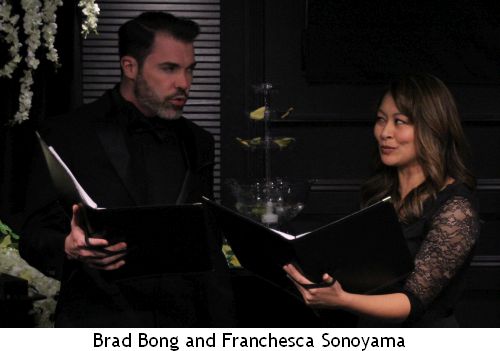 It has been Victor Herbert’s music that sparked the early success of
this operetta and that has preserved its appeal over the past century. I
enjoyed all the music, especially the songs that were familiar to me:
“I’m Falling in Love with Someone” and “Italian Street Song” (you’d
recognize it if you heard it). Then there’s “Ah, Sweet Mystery of Life.”
This song is a mere seed of a melody early in the plot. Marietta can
sing only a few notes that came to her in a dream. Furthermore, she is
convinced that the man who can complete the song will be the one she is
destined to marry. The climax comes when Captain Dick is able to
complete the song, which becomes a duet with Marietta in the finale to
the operetta.
It has been Victor Herbert’s music that sparked the early success of
this operetta and that has preserved its appeal over the past century. I
enjoyed all the music, especially the songs that were familiar to me:
“I’m Falling in Love with Someone” and “Italian Street Song” (you’d
recognize it if you heard it). Then there’s “Ah, Sweet Mystery of Life.”
This song is a mere seed of a melody early in the plot. Marietta can
sing only a few notes that came to her in a dream. Furthermore, she is
convinced that the man who can complete the song will be the one she is
destined to marry. The climax comes when Captain Dick is able to
complete the song, which becomes a duet with Marietta in the finale to
the operetta.
(Click here to open the program in a new window.)
When it was time for the show to start on this evening, Sam Schieber entered the theater and without comment sat down at the piano and started playing. A 10-man chorus entered, taking positions behind the piano as they sang from printed scores. Presently, 10 women entered and joined the men in the high-spirited opening chorus. All the singers were dressed in black, though most of the women had flowered hairpieces of different colors. I was immediately impressed with the quality of the ensemble singing in this chorus, and all those strong voices were almost overpowering in the small theater.
I was soon impressed with the individual singing, as well. Franchesca
Sonoyama was the coquettish Marietta, and though she didn’t immediately
charm Captain Dick, she charmed the audience from the start with her
inspired acting and her cultured high soprano voice. Brad Bong was the
stolid Captain Dick, and he displayed a brilliant high tenor voice to
match Sonoyama’s soprano. But throughout the night I heard excellent
singing from others whose voices I’ve learned to appreciate over the
years.
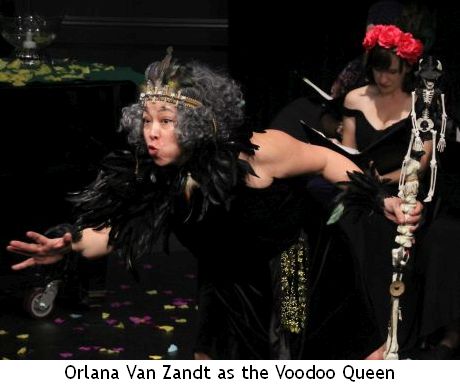 For example, Lisa Singh was especially expressive in singing
“'Neath the Southern Moon.” And Madeleine Wieland got many laughs with
her “The Sweet By and By.” I also noted quality singing from Pano
Roditis, Danny Beldi, and Jonathan Blum. Many others did well with
shorter singing parts or incidental solos in ensemble pieces. And Flower
Girls, Kerry Brown and Vanessa Archuleta added brief dances to their
singing. I especially enjoyed the quartet composed of Sonoyama, Singh,
Bong and Roditis. And what made all this music authentic was the
expressive, energetic playing of Sam Schieber, which was the soul of the
entire performance.
For example, Lisa Singh was especially expressive in singing
“'Neath the Southern Moon.” And Madeleine Wieland got many laughs with
her “The Sweet By and By.” I also noted quality singing from Pano
Roditis, Danny Beldi, and Jonathan Blum. Many others did well with
shorter singing parts or incidental solos in ensemble pieces. And Flower
Girls, Kerry Brown and Vanessa Archuleta added brief dances to their
singing. I especially enjoyed the quartet composed of Sonoyama, Singh,
Bong and Roditis. And what made all this music authentic was the
expressive, energetic playing of Sam Schieber, which was the soul of the
entire performance.
Orlana Van Zandt needs a special comment. She played Marie le Valleau,
the Voodoo Queen. Van Zandt came out for “The Voodoo Song” early in Act I, and
I’m sure everyone in the audience was stunned, first by her appearance,
then by her performance. She had an outrageous wig that was frightful in
itself, as was her make-up. She carried an elaborate cane topped with a
small skull. I don’t recall her underlying costume well enough to
describe it, but she wore a big gold necklace, and over it a large
feathered scarf. Above her bare feet were feathers around her
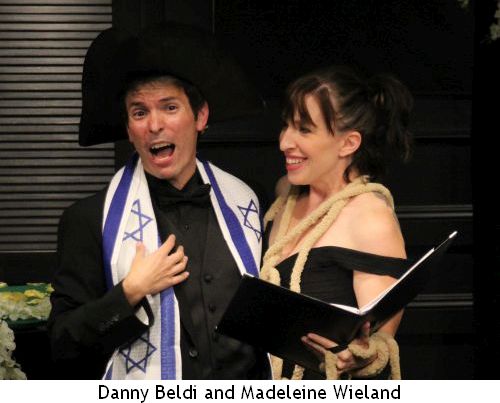 ankles.
There were a few children in the audience, and I’d say this costume made
them and their family glad they weren’t in the first row. But the
costume wasn’t all that was frightening. I’ve heard Van Zandt sing
beautifully in past concerts, but on this occasion she summoned up
something quite sinister. She performed her song with a voice that was
more stentorian than tuneful, while she danced around menacingly. At one
point she raised chorus members from their seats, as if by a spell. Of
the fine performances of the evening, this was in a class by itself.
ankles.
There were a few children in the audience, and I’d say this costume made
them and their family glad they weren’t in the first row. But the
costume wasn’t all that was frightening. I’ve heard Van Zandt sing
beautifully in past concerts, but on this occasion she summoned up
something quite sinister. She performed her song with a voice that was
more stentorian than tuneful, while she danced around menacingly. At one
point she raised chorus members from their seats, as if by a spell. Of
the fine performances of the evening, this was in a class by itself.
I've mentioned Sam Schieber's sense of humor, and part of that is
testing limits and delivering surprises. Naturally, he has attracted
people who love to play along with his inspired fun. They’re an
irrepressible bunch, and so throughout this performance there were
clever props, sight gags, and a bit of physical humor
― to go along with the witticisms that
were written into the script and that were enhanced by good acting. Schieber can give these people a humorous bit (a line or a prop) or a
humorous part and count on them to make the most of it. So Madeleine
Wieland was effervescent and uninhibited as Lizette. Eddie Voyce
embraced the part of the blind servant of the Lieutenant Governor with
one sight gag after another (no pun intended). And in the bidding for
the sale of slave Adah, one of the men in the back of the group was the
main bidder, sporting wild hair and a beard so full that nothing
was visible about his face except his mouth.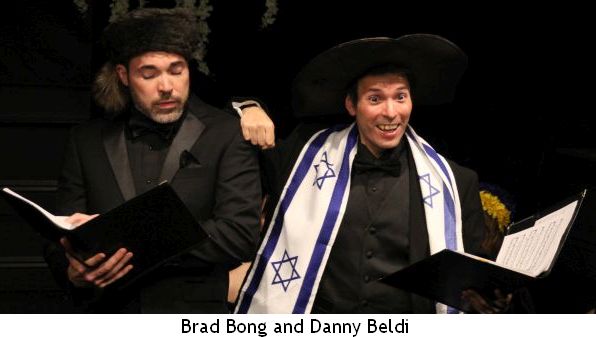
Danny Beldi was the epitome of all this craziness in his role as Simon O’Hara, the Yiddish servant of Captain Dick. I’d say he had the hardest part of all the actor-singers as he maintained his Yiddish accent throughout the performance of his substantial role: singing, scheming, fawning, sniveling ― with all the overacting that the part demanded.
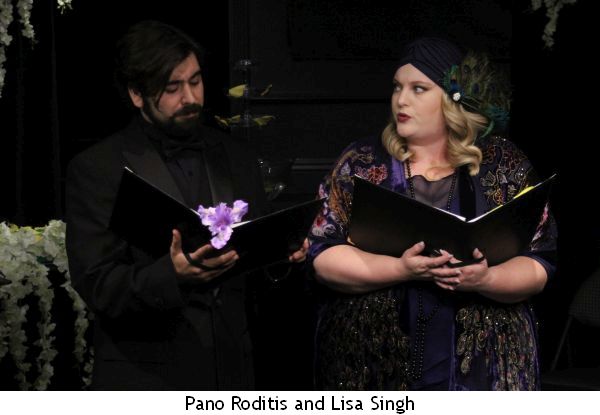 This was “reader’s theater” to a large extent, with many performers
reading their lines from the script or singing from scores. There were
many exceptions, though, especially for the biggest solo numbers and for
key scenes (particularly when props were involved). Script and scores
notwithstanding, I was impressed with the general quality of the acting
and, of course, the singing.
This was “reader’s theater” to a large extent, with many performers
reading their lines from the script or singing from scores. There were
many exceptions, though, especially for the biggest solo numbers and for
key scenes (particularly when props were involved). Script and scores
notwithstanding, I was impressed with the general quality of the acting
and, of course, the singing.
I’ve commented about the Voodoo Queen’s costume. Writing this two days after witnessing the performance, I recall at least one other notable costume, that of Lisa Singh as Adah, the slave. Her outfit was a beautiful, artistic, colorful construction, showing that a lot of thought had gone into creating it. There was also a walk-on part for a nun who had a full costume, with a “Flying Nun” headpiece. For most of the other performers, a simple hat, scarf, mask, or other item was sufficient to evoke the idea of a costume.
Let's face it, for all of its good music, the “book” of this show is dated in so many ways. But “old” isn't “bad” ― it's just different. And what made this presentation so entertaining, besides the genius and effort of Sam Schieber, is that all these performers set aside their inhibitions and really embraced this show. And because they did, we in the audience embraced it, too. Then after initial bows after “Ah, Sweet Mystery of Life,” there was a rousing reprise of “Italian Street Song” and showers of colorful flower petals crowning a rare and satisfying entertainment experience.
Dick Frantzreb is editor of the Capital Region Performance Gallery. He also edits the Sacramento Choral Calendar and the Placer Performance Calendar, and he was a co-founder and past President of the Sacramento Valley Choral Coalition. He has been loving live performances in the greater Sacramento area and writing about them since 2012.